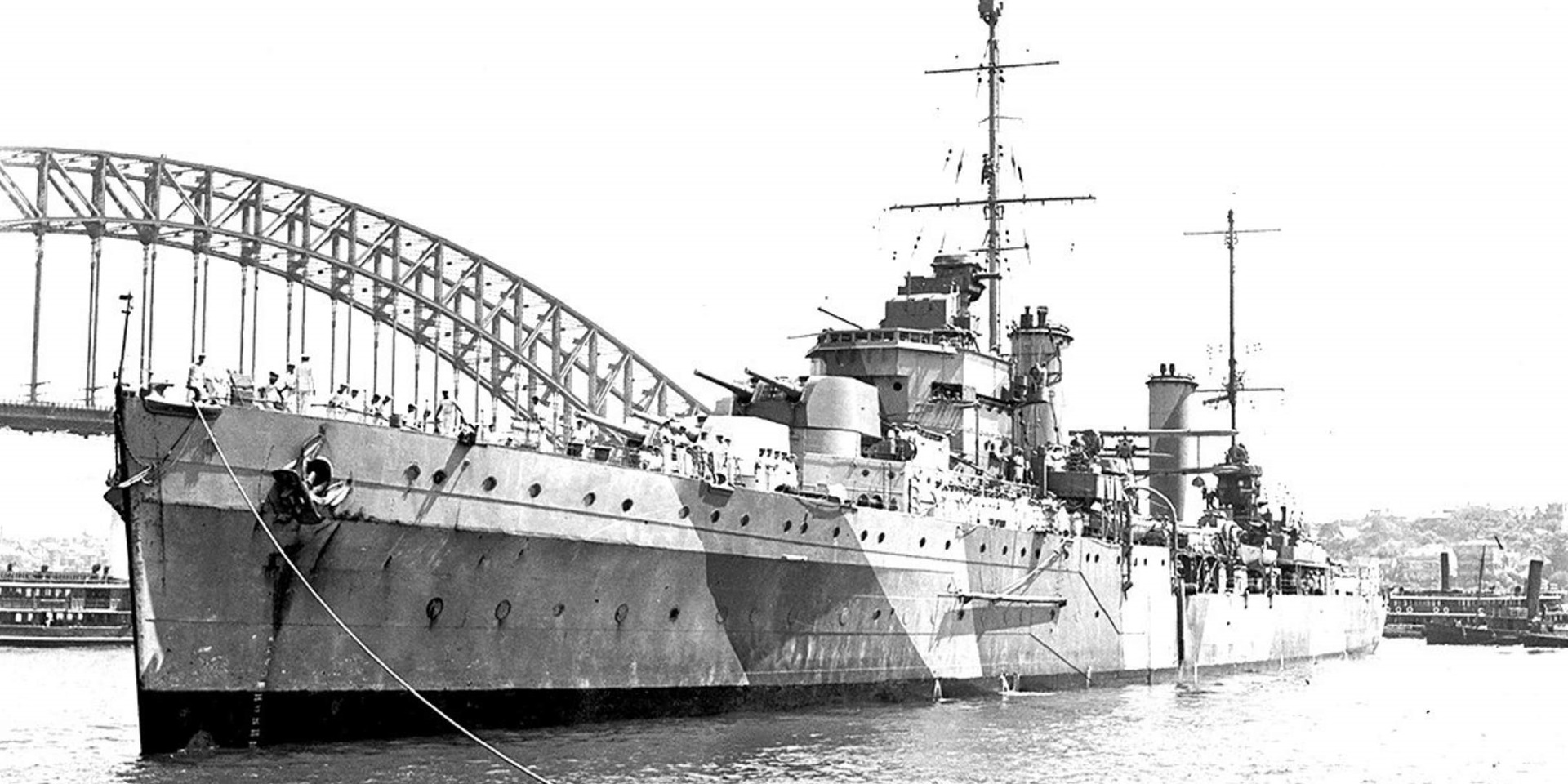
On 11 November (Armistice Day) 1941, the Modified Leander Class light cruiser HMAS Sydney (II) pulled away from Victoria Quay in Fremantle, Western Australia and proceeded to leave harbour. The Second World War was in its third year and Sydney, which had recently returned to Australia after serving with distinction in the Mediterranean Theatre, was tasked with escorting the troopship Zealandia to Indonesia’s Sunda Strait. Following an uneventful six-day passage, Sydney rendezvoused with the light cruiser HMS Durban, to which it transferred responsibility for Zealandia and the final leg of the troopship’s voyage to Singapore. As Sydney reversed course and began the return journey to Fremantle, those aboard Zealandia and Durban could not have known that they would be among the last people to see the warship then regarded as the ‘pride of the Royal Australian Navy’ for another sixty-six years.
By mere chance, the two ships encountered one another on the afternoon of 19 November. The naval engagement that followed lasted less than an hour, resulted in the loss of both ships, and spawned one of Australia’s greatest naval mysteries.
As Sydney steamed south, a disguised commerce raider of Nazi Germany’s navy, the Kreigsmarine, was cruising north along the coast of Western Australia. The vessel, HSK Kormoran, had been engaged in disrupting Allied merchant shipping in the Indian Ocean for seven months, and was on its way to lay mines in Shark Bay. Once this mission was completed, the raider would continue north to the East Indies (modern-day Indonesia) before heading west to the Bay of Bengal.
By mere chance, Sydney and Kormoran encountered one another on the afternoon of 19 November. The naval engagement that followed lasted less than an hour, resulted in the loss of both ships, and spawned one of Australia’s greatest naval mysteries. Seventy-five years later, the outcome of the battle between Sydney and Kormoran still has resonance, and the recent discovery and ongoing archaeological investigation of their respective shipwreck sites has contributed to our understanding of the two vessels and the showdown that resulted in their mutual destruction.
HMAS Sydney (II) shortly after its launch, 22 September 1934. Image: State Library of Victoria H98.105/2530.
HMAS Sydney (II)’s Origins and Early Naval Career
HMAS Sydney (II) was laid down as HMS Phaeton for the British Royal Navy. It was constructed at the shipyard of Swan, Hunter and Wigham Richardson at Wallsend-on-Tyne, England during 1933 and 1934. The vessel was purchased by the Australian government while still on the stocks and renamed prior to its launch on 22 September 1934. Sydney was commissioned into the Royal Australian Navy (RAN) on 24 September 1935 and drew much of its complement from the cruiser HMAS Brisbane (I), which decommissioned the same day. Upon completing month-long sea trials, Sydney departed for Australia, but was almost immediately reassigned to join the Royal Navy’s Mediterranean Fleet to participate in an economic blockade of Italy in response to the Abyssinian Crisis. Following resolution of the crisis in July 1936, Sydney finally completed its inaugural voyage to Australia.
Postcard showing Sydney at sea, c. 1930s. Photographer: White and Logan / ANMM Collection 00013943.
Two years later, Sydney was one of several RAN assets ordered to prepare to respond to the Munich Crisis, but ultimately stood down when it was averted. However, only another year would pass before the cruiser was ordered to Western Australia on a war footing, this time in response to events that culminated in the outbreak of the Second World War. Following the commencement of hostilities, Sydney conducted patrols and escort duties in Australian waters. On 28 November 1939, it joined the Australian heavy cruisers Australia (II) and Canberra (I) in an unsuccessful search of the Indian Ocean for the German pocket battleship Admiral Graf Spee. Sydney resumed home water patrols and escort duty until April 1940, when it was assigned to the East Indies Station in Ceylon (Sri Lanka). It was reassigned to the Mediterranean Theatre the following month, where it re-joined the Royal Navy’s Mediterranean Fleet.
Ink-on-linen tracking chart showing Sydney's operations in the Mediterranean during the Second World War. ANMM Collection 00031716.
Sydney’s Mediterranean Service
Sydney’s deployment to the Mediterranean proved eventful. On 21 June 1940 it participated in the shelling of the Italian port of Bardia, and shortly thereafter turned its guns on the French battleship Lorraine to help prevent it from falling into Axis hands following the armistice between Nazi Germany and Vichy France. While escorting a Malta Convoy on 28 June, Sydney helped engage three Italian destroyers, one of which—Espero—was heavily damaged. Tasked with recovering survivors, Sydney was forced to sink Espero after the destroyer unexpectedly fired two salvoes. The cruiser then resumed recovering survivors, and left a fully provisioned cutter for those Espero crewmen it was unable to rescue.
Commemorative plaque depicting Sydney's victory over Bartolomeo Colleoni. Designer: Calman Folkes / ANMM Collection 00019514.
On 9 July 1940, Sydney was one of several Allied warships that engaged an Italian fleet near Punta Stilo on the ‘toe’ of the Italian mainland. It made visual contact with five cruisers in the opening phase of what came to be known as the Battle of Calabria, and opened fire on one of them from a distance of 21 kilometres. Both the Allied and Italian warships traded several salvoes, but failed to hit one another. However, as the engagement came to an end, Sydney shelled a destroyer that was creating a smokescreen to cover the Italian fleet’s retreat.
Shell damage to Sydney's forward funnel during the Cape Spada action. Photographer: Arthur Thomas Wood / ANMM Collection ANMS0845[027].
Ten days later, Sydney engaged the Italian light cruisers Giovanni delle Bande Nere and Bartolomeo Colleoni in an action off Cape Spada. During the battle, Sydney’s shellfire damaged Bande Nere and struck Colleoni in the engine room, immobilising it. The British destroyers HMS Ilex and HMS Hyperion finished off Colleoni with torpedoes while Sydney pursued Bande Nere. Although damaged, the Italian cruiser proved faster than its Australian pursuer, and managed to escape. Sydney’s only damage during the engagement was a shell hit to its forward funnel. One crewman was slightly injured by shrapnel.
Sydney’s Seagull A2-4 amphibious aircraft operates in the Mediterranean Sea during the pre-Second World War period. The cruiser’s Walrus aircraft was a later modification of the Seagull design. Photographer: Arthur Thomas Wood / ANMM Collection ANMS0845[032].
The remainder of Sydney’s Mediterranean deployment primarily involved convoys to Malta and Greece. It also participated in a number of shore bombardments and naval engagements, including one in the Strait of Otranto on 12 November 1940 that damaged an Italian destroyer and resulted in the destruction of four Italian merchant ships. One of the cruiser’s final missions was to help transport 4,000 Allied troops and their equipment from Alexandria to Piraeus to reinforce Greece against invasion. In December Sydney was relieved by HMAS Perth (I). On 9 January 1941 Sydney received orders to return to Australia to defend home waters from German commerce raiders. It arrived at its namesake port early the following month.
References
- Cover image: Sydney moored in front of the Sydney Harbour Bridge, 10 February 1941. Photographer: Samuel J. Hood Studios / ANMM Collection 00020357.
